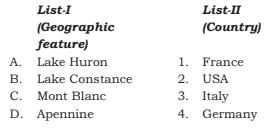Manipur PSC Prelims Paper 1 Mock Test - 6 - Manipur CSCCE MCQ
30 Questions MCQ Test Manipur PSC Mock Test Series 2025 - Manipur PSC Prelims Paper 1 Mock Test - 6
Who was the last ruler of the Kingdom of Manipur
The illustrated manuscript of the Nimat Nama, a blend of Indian and Persian styles is a/an:
Consider the following statements regarding Ahoms
1. The Ahoms migrated to the Brahmaputra valley from present-day Bangladesh in the thirteenth century.
2. The Ahom state depended upon forced labour called paiks.
Which of the statements given above is/are correct?
1. The Ahoms migrated to the Brahmaputra valley from present-day Bangladesh in the thirteenth century.
2. The Ahom state depended upon forced labour called paiks.
Maharaja Sawai Jai Singh II of Amber was a great patron of astronomy. In this context, in which of the following places he built astronomical observatories (Jantar Mantar)?
1. Delhi
2. Jaipur
3. Varanasi
4. Ujjain
5. Mathura
Select the correct answer using the code given below.
In the context of medieval India, the 'batai' and 'nasaq' were
Chennai is often called the 'Detroit of India'. In this context, Detroit is famous for and has in common with Chennai which of the following industries?
Consider the following statements about the Goldilocks zone :
1. It is a habitable zone around a star where it is not too hot and not too cold for liquid water to exist.
2. Venus and Mars are also part of the Goldilocks zone in our solar system.
3. The celestial bodies within the Goldilocks zone must have an atmosphere.
Which of the above statements is/are correct ?
Match List-I with List-II and select the correct answer using the codes given below :

The idea of Rule of law in the Indian Constitution is borrowed from
Consider the following provisions of the Constitution of India:
- Citizenship
- Electoral Process in India
- Fundamental Duties
- Fundamental Rights
- Formation of States and Union Territories
Which of the above provisions came into existence on November 26, 1949?
Consider the following statements:
I. The Preamble provides the citizens the liberty of thought, expression, belief, faith and worship.
II. The citizens are entitled to unhindered liberty.
Choose the right answer:
With reference to the Fiscal Responsibility and Budget Management(FRBM) Act, consider the following statements:
1. The FRBM Act bans the purchase of primary issues of the Central Government securities by the RBI.
2. The rules under the FRBM Act aim to eliminate the fiscal deficit of the Central Government.
Which of the statements given above is/are correct?
Consider the following :
1. Investment on health
2. Firms spending on the job training
3. Budget allocation on agriculture subsidies
4. Buying an S-400 air defense missile system from Russia
5. Investment in education
Which of the scenarios mentioned above are the source of Human Capital Formation ?
With reference to Commercial Paper', consider the following statements:
- It is a short-term debt instrument issued to raise funds for less than one year.
- They are issued in the form of a promissory note and are not backed by collateral.
- It can only be issued by scheduled commercial banks in India.
Which of the statements given above is/are correct?
Consider the following protected areas:
1. Pin Valley National Park
2. Kibber Wildlife Sanctuary
3. Kitam Bird Sanctuary
How many of the above protected areas are a part of the Cold Desert Biosphere Reserve?
Consider the following statements
- ISRO built India's first satellite, Aryabhata.
- Rohini became the first satellite to be placed in orbit by an Indian-made launch vehicle
- ISRO is the first Asian space agency to reach Mars orbit.
Which of the statements given above are correct?
The ‘three-drug regimen’ of dapsone, rifampicin and clofazimine, recently approved by the Governmentof India for which of the following diseases?
Consider the following with respect to ‘Srimukhalingam temple’
- Srimukhalingam temple is located in the Indian state of Andhra Pradesh.
- The temple is built in the Vesara architectural style.
- It was built by Kamarnava II, ruler from the family line of Eastern Ganga.
Select the correct statement(s)
Which king of Magadha founded the city of Rajgriha?
Consider the following statements:
- The Amaravati Stupa, enhanced during the Satavahana period, showcases intricate carvings that depict scenes from the Jataka tales.
- All Satavahana rulers used the title 'Satakarni'.
- The Satavahanas imposed a strict tax system that was uniform across their empire.
How many of the statements given above are correct?
During Harsha's reign, which religion was predominant in India?
At which conference did Gandhi strive to win round M.A. Jinnah?
What is the main difference between the Mughal school of painting and the Rajput school of painting?
Which monument is considered the greatest example of Indo-Java art?
Who emerged victorious against King Harshavardhana in the military campaign according to the Aihole inscription?
In which region did King Harshavardhana's empire center around?














